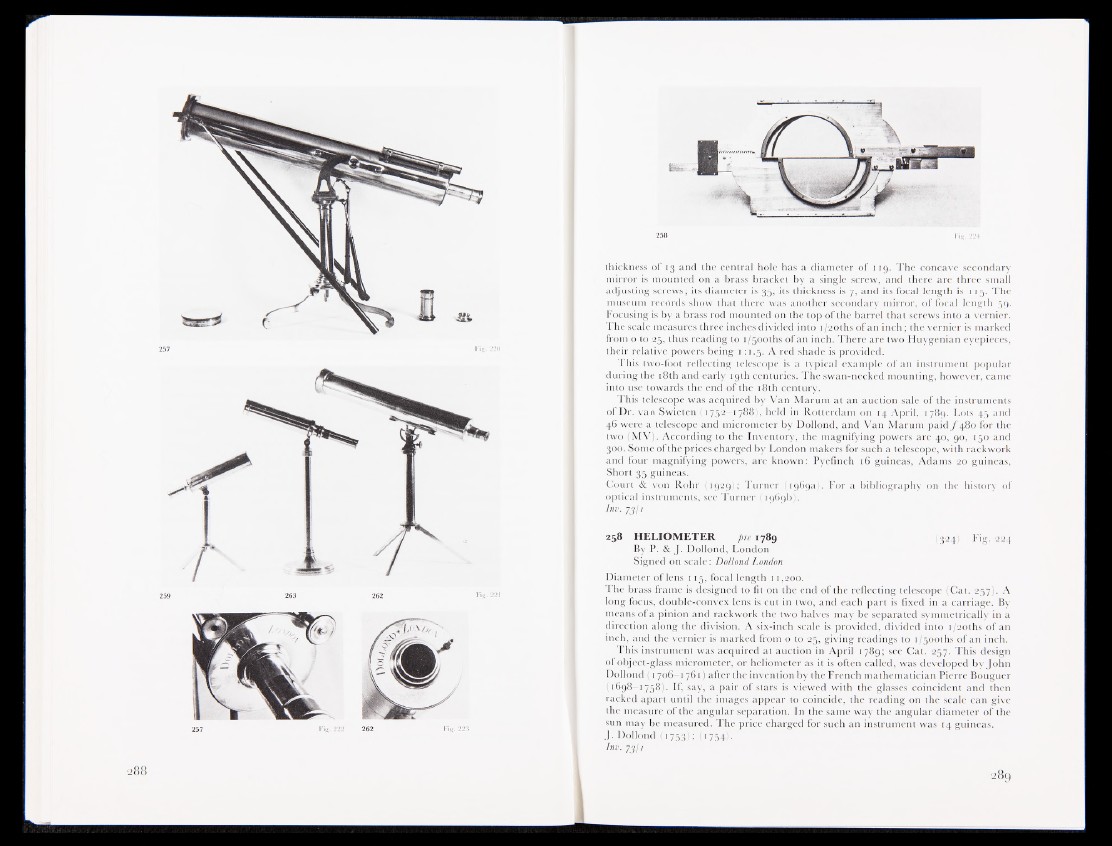
I
2 58
thickness of 13 and the central hole has a diameter of 119. The concave secondary
mirror is mounted on a brass bracket by a single screw, and there are three small
adjusting screws; its diameter is 35, its thickness is 7, and its focal length is 115. The
museum records show that there was another secondary mirror, of focal length 59.
Focusing is by a brass rod mounted on the top of the barrel that screws into a vernier.
The scale measures three inches divided into i/20ths of an inch; the vernier is marked
from o to 25, thus reading to i/500ths of an inch. There are two Huygenian eyepieces,
their relative powers being 1:1.5. A red shade is provided.
This two-foot reflecting telescope is a typical example of an instrument popular
during the 18th and early 19th centuries. The swan-necked mounting, however, came
into use towards the end of the 18th century.
This telescope was acquired by Van Marum at an auction sale of the instruments
of Dr. van Swieten (1752-1788), held in Rotterdam on 14 April, 1789. Lots 45 and
46 were a telescope and micrometer by Dollond, and Van Marum paid ƒ 480 for the
two (MV). According to the Inventory, the magnifying powers are 40, 90, 150 and
300. Some of the prices charged by London makers for such a telescope, with rackwork
and four magnifying powers, are known: Pyefinch 16 guineas, Adams 20 guineas,
Short 35 guineas.
Court & von Rohr (1929); Turner (ig6gaHFor a bibliography on the history of
optical instruments, see Turner (1969b).
Inv. 75//
258 HELIOMETER pre 1789 (324) Fig. 224
By P. & J. Dollond, London
Signed on scale: Dollond London
Diameter of lens 115, focal length 11,200.
The brass frame is designed to fit on the end of the reflecting telescope (Cat. 257). A
long focus, double-convex lens is cut in two, and each part is fixed in a carriage. Bv
means of a pinion and rackwork the two halves may be separated symmetrically in a
direction along the division. A six-inch scale is provided, divided into i/20ths of an
inch, and the vernier is marked from o to 25, giving readings to i/500ths of an inch.
This instrument was acquired at auction in April 1789; see Cat. 257. This design
of object-glass micrometer, or heliometer as it is often called, was developed by John
Dollond (1706—1761) after the invention by the French mathematician Pierre Bouguer
(1698-1758). If, say, a pair of stars is viewed with the glasses coincident and then
racked apart until the images appear to coincide, the reading on the scale can give
the measure of the angular separation. In the same way the angular diameter of the
sun may be measured. The price charged for such an instrument was 14 guineas.
,J. Dollond (1753); (1754). H 7311